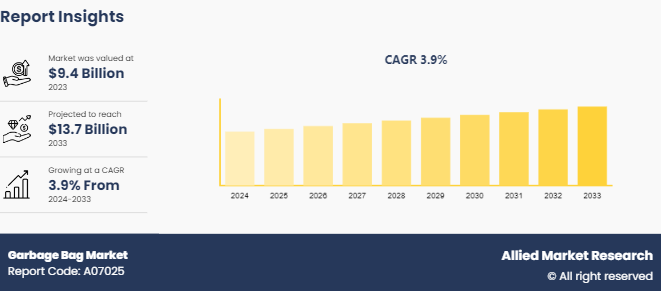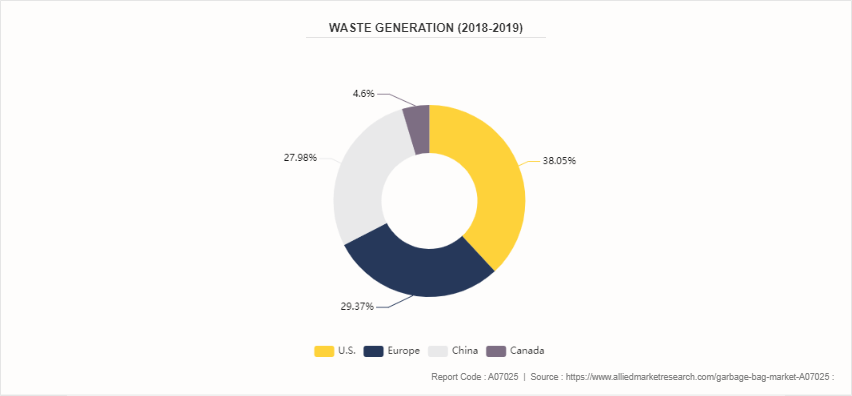Garbage Bag Market Research, 2033
The global garbage bag market was valued at $9.4 billion in 2023, and is projected to reach $13.7 billion by 2033, growing at a CAGR of 3.9% from 2024 to 2033.

Market Introduction and Definition
The garbage bags market encompasses the production, distribution, and sale of disposable bags specifically designed for the collection and disposal of household, commercial, and industrial waste. These bags, often made from materials like high-density polyethylene (HDPE) or low-density polyethylene (LDPE) , are essential for maintaining cleanliness and hygiene in various settings, including homes, offices, hospitals, restaurants, and manufacturing facilities. Garbage bags are available in different sizes, colors, and strengths to accommodate different types and volumes of waste. They are typically equipped with features such as drawstrings, handles, or tie closures to facilitate easy sealing and transportation of waste. The market caters to diverse consumer needs, ranging from everyday household use to specialized requirements in sectors like healthcare and hospitality.
Key Takeaways
The garbage bags market study covers 20 countries. The research includes a segment analysis of each country in terms of value for the projected period.
More than 1, 500 product literatures, industry releases, annual reports, and other such documents of major industry participants along with authentic industry journals, trade associations' releases, and government websites have been reviewed for generating high-value industry insights.
The Garbage Bag Marketstudy integrated high-quality data, professional opinions and analysis, and critical independent perspectives. The research approach is intended to provide a balanced view of global markets and assist stakeholders in making educated decisions to achieve their most ambitious growth objectives.
Key market dynamics
The growing awareness about hygiene and sanitation, especially in households, healthcare facilities, and food service establishments, drives the demand for Garbage Bag Market. These bags are essential for containing and disposing of waste safely and efficiently, contributing to a cleaner and healthier environment.
Urbanization and population growth lead to higher volumes of waste generation, particularly in urban areas where efficient waste management is crucial. This trend escalates the demand for garbage bags across residential, commercial, and industrial sectors as municipalities and businesses seek effective waste disposal solutions.
Increasing environmental concerns regarding plastic waste pose a significant restraint on the garbage bags market. The use of traditional plastic bags contributes to plastic pollution, prompting regulatory scrutiny and consumer preferences shifting towards more sustainable alternatives, contributing to Garbage Bag Industry.
Price sensitivity among consumers and businesses can restrain market growth, especially in price-sensitive markets where cheaper alternatives or reusable options are preferred over disposable garbage bags. Economic fluctuations and cost pressures in raw materials also impact pricing dynamics within the market.
Shift towards sustainable materials in garbage bag production is opportunistic for the market growth. There is a growing demand for biodegradable, compostable, and recycled materials that offer environmental benefits without compromising performance. Manufacturers investing in research and development of eco-friendly alternatives stand to capitalize on this trend, meeting regulatory requirements and appealing to environmentally conscious consumers and businesses, increasing the Garbage Bag Market Size.
Value Chain of garbage bags market
The value chain of the garbage bags market begins with raw material suppliers providing materials such as HDPE, LDPE, recycled plastics, and biodegradable alternatives. Manufacturers then process these materials through extrusion and molding processes to produce a variety of garbage bag types and sizes. Following manufacturing, the bags are packaged and distributed through wholesalers, distributors, and retailers, including supermarkets, home improvement centers, and online platforms. End-users, ranging from households to commercial entities like hospitals and restaurants, purchase and utilize garbage bags for waste management purposes. After use, waste disposal occurs through municipal collection systems, recycling initiatives, or landfill disposal, completing the value chain. Throughout each stage, stakeholders collaborate to ensure product availability, quality, and sustainability, with ongoing innovations driving advancements in materials, manufacturing techniques, and environmental stewardship within the garbage bags market.
Market Segmentation
The garbage bags market is segmented into product type, end-user, distribution channel and region. On the basis of product type, it is divided into recyclable bags and non- recyclable bags. On the basis of end-user, it is categorized into residential, commercial and Industrial. On the basis of distribution channel, it is bifurcated into offline channel and online channel. Region-wise, it is analyzed across North America, Europe, Asia-Pacific and LAMEA.
Regional/Country Market Outlook
In the U.S., the garbage bags market reflects robust demand driven by widespread use across residential, commercial, and industrial sectors. The market benefits from a large consumer base and high levels of waste generation, supported by a strong emphasis on hygiene and waste management practices. According to national statistics, the US generates approximately 292.4 million tons of municipal solid waste annually, highlighting the substantial demand for effective waste containment solutions like garbage bags. Moreover, increasing environmental awareness is pushing demand towards eco-friendly options, such as biodegradable and compostable materials, alongside traditional plastic bags, increasing the Garbage Bag Market Share. The market is competitive, with key players focusing on innovation in design and sustainability to meet evolving consumer preferences and regulatory requirements.
In China, the garbage bags market is influenced by rapid urbanization, population growth, and expanding municipal infrastructure. The country faces significant challenges related to waste management due to its large population and industrialization, leading to substantial demand for garbage bags across residential, commercial, and municipal sectors. National statistics indicate that China is one of the world's largest producers of municipal solid waste, prompting stringent regulations and policies aimed at improving waste management practices. The market in China is characterized by a shift towards sustainable materials and technologies, driven by government initiatives to reduce environmental impact and promote recycling. Key players in the market are investing in research and development of innovative products to cater to diverse consumer needs and enhance market competitiveness.
Industry Trends
Manufacturers in the garbage bags market focus majorly on sustainability and the use of eco-friendly materials. Consumers and businesses are increasingly conscious of the environmental impact of plastic waste, including garbage bags. As a result, there is a growing demand for biodegradable, compostable, or recycled materials in garbage bag production. Manufacturers are responding by developing bags made from materials such as plant-based bioplastics, recycled plastics, or oxo-biodegradable polymers that break down more readily in landfill conditions, contributing to Garbage Bag Market Growth. These eco-friendly alternatives aim to reduce the carbon footprint associated with traditional plastic bags while meeting regulatory standards for environmental sustainability. Additionally, brands are focusing on educating consumers about the benefits of using eco-friendly garbage bags and promoting responsible waste management practices to further drive adoption.
Manufacturers are continuously introducing new features and improvements to enhance the performance and user experience of garbage bags. This includes developing bags with reinforced bottoms for durability, odor-control technologies to minimize unpleasant smells, and anti-leak barriers for enhanced containment of liquids. Convenience-focused innovations such as easy-open tear strips, ergonomic handles for comfortable carrying, and space-saving compact designs are also gaining popularity. Moreover, there is a trend towards customizable options, where businesses and consumers can choose specific sizes, colors, and thicknesses to suit their individual waste management needs, increasing the Garbage Bag Market Demand. Advanced manufacturing techniques and materials allow for greater flexibility in design, enabling garbage bags to meet a wide range of application requirements across residential, commercial, and industrial sectors.

Competitive Landscape
The major players operating in the garbage bags market include SARANTIS S.A., Polykar Industries Inc., The Glad Products Company, Green Groundswell, The Clorox Company, Berry Global Inc., Big Black Sacks, Novolex Holdings LLC, Thantawan Industry Plc. and Plasticplace.com.
Recent Key Strategies and Developments
In February 2020, The RKW Group, which is a German plastic firm manufacture expanded its waste bag production facilities by commissioning 2 production line of capacity 3000 tons per year at the site of Echte, Germany.
In June 2020, Polykar Industries Inc. a Quebec based American leader in sustainable packaging set up their plant at Ville Saint-Laurent. The plant has the capacity to recycle 10, 000 tons of commercial and industrial plastic waste annually and therefore can be efficiently utilized to develop a large volume of recyclable garbage bags.
Key Sources Referred
The RKW Group
Economic Times
Key Benefits For Stakeholders
- This report provides a quantitative analysis of the market segments, current trends, estimations, and dynamics of the garbage bag market analysis from 2024 to 2033 to identify the prevailing garbage bag market opportunities.
- The market research is offered along with information related to key drivers, restraints, and opportunities.
- Porter's five forces analysis highlights the potency of buyers and suppliers to enable stakeholders make profit-oriented business decisions and strengthen their supplier-buyer network.
- In-depth analysis of the garbage bag market segmentation assists to determine the prevailing market opportunities.
- Major countries in each region are mapped according to their revenue contribution to the global market.
- Market player positioning facilitates benchmarking and provides a clear understanding of the present position of the market players.
- The report includes the analysis of the regional as well as global garbage bag market trends, key players, market segments, application areas, and market growth strategies.
Garbage Bag Market Report Highlights
| Aspects | Details |
| Market Size By 2033 | USD 13.7 Billion |
| Growth Rate | CAGR of 3.9% |
| Forecast period | 2024 - 2033 |
| Report Pages | 456 |
| By Product Type |
|
| By End-User |
|
| By Distribution Channel |
|
| By Region |
|
| Key Market Players | The Glad Products Company, Berry Global Inc., SARANTIS S.A., Big Black Sacks, Polykar Industries Inc., Novolex Holdings LLC, Plasticplace.com., Green Groundswell, Thantawan Industry Plc., The Clorox Company |
The most significant application of garbage bags is in households for managing everyday waste.
Increasing environmental awareness and stricter regulations are driving the demand for biodegradable and compostable garbage bags.
The major players operating in the garbage bags market include SARANTIS S.A., Polykar Industries Inc., The Glad Products Company, Green Groundswell, The Clorox Company, Berry Global Inc., Big Black Sacks, Novolex Holdings LLC,Thantawan Industry Plc. and Plasticplace.com.
The largest regional market for garbage bags is North America.
The global garbage bag market was valued at $9.4 billion in 2023, and is projected to reach $13.7 Billion by 2033, growing at a CAGR of 3.9% from 2024 to 2033.
Loading Table Of Content...



